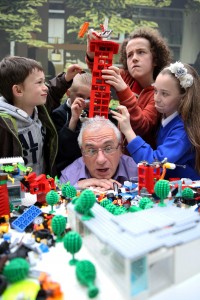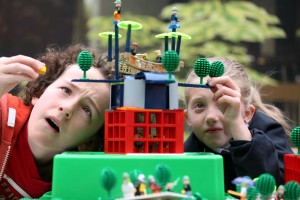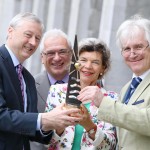Interactive Digital Showcase offers a window on the future
A fascinating and eye-opening Digital Showcase, open free to the public took place in The Round Room of Dublin’s Mansion House from noon on Monday May 20th until 5pm on Tuesday May 21st. The showcase offered the public a ‘window on the future’ demonstrating how technological innovation is affecting every aspect of our lives from our homes and gardens to our work, our schools and our city. Over 20 groundbreaking new technological advances and developments were on display to the public, allowing the opportunity to interact with new technologies and to see how these will have a positive impact on life in Dublin city.
 The showcase was broken into zones such as home; work; school; city; environment and garden, and each zone included demonstrations displaying the innovation taking place in Ireland and internationally. A special showcase and workshop by the iconic company Lego under canvass on the forecourt of the Mansion House involved people of all ages using Lego to build their vision of the Dublin of the future. This “Build the Change” Lego workshop has taken place in 10 cities across Europe. A remarkable giant interactive social media wall allowed the public to view and interact with up-to-the-minute social media commentary on the event and ideas on how Dublin can engage more with digital technology.
The showcase was broken into zones such as home; work; school; city; environment and garden, and each zone included demonstrations displaying the innovation taking place in Ireland and internationally. A special showcase and workshop by the iconic company Lego under canvass on the forecourt of the Mansion House involved people of all ages using Lego to build their vision of the Dublin of the future. This “Build the Change” Lego workshop has taken place in 10 cities across Europe. A remarkable giant interactive social media wall allowed the public to view and interact with up-to-the-minute social media commentary on the event and ideas on how Dublin can engage more with digital technology.
Lord Mayor of Dublin Naoise Ó Muirí urged the public to attend this unique showcase: “Technology is changing every aspect of our lives. The Showcase event in May allows Dubliners to experience how technology will affect them. This Showcase is another milestone in the development of our Digital Masterplan for Dublin.”
The Irish-led initiative ‘Behavioural Prediction’, developed by Intel, ESB Networks, SAP and M2C shows how by analysing available data people’s behaviour can be effectively predicted from the time they wake in the morning and when they leave the house to when they arrive home and like to cook their dinner. This demo demonstrated how these predictions can be used to set someone’s alarm clock, open & heat their car before they get in and set timings for switching on lights in anticipation of them arriving home.
Another demonstration that took place at the showcase was CityWatch, a project developed by Intel, Dublin City Council and Trinity College Dublin. This project allows citizens to interact on issues that affect their lives. Citizens become active participants in ensuring that public services meet their needs. They can for example help the city become more sustainable. Wasteful behaviour such as lights on at night in office buildings, buses idling or windows opened in heated buildings are common, much of which can be, and is, observed by citizens. CityWatch demonstrates how the power of the crowd can be harnessed to signal wasteful practices and highlight green initiatives, turning citizens into “reporters” creating a dynamic green map of Dublin and creating the impetus for a greener Dublin.
Tying in with CityWatch is Intel’s Urban Garden Monitoring project, which places sensors in community gardens in Dublin. The Citywatch “app” displays real-time data such as soil temperature, soil moisture and weather. Members of each garden are able to tag upcoming events in their garden and their city which may be of interest to others. Tagged items can be shared across other social networks and the “taggers” receive points, which may lead to rewards from the city.
Sonitus Systems and Dublin City Council have developed a monitoring platform which provides better understanding of noise levels throughout the city, allowing for more effective policy and planning and protection of citizens from excess noise pollution. By providing an open public interface Dublin City Council aims to promote education and awareness regarding environmental noise and provide useful information to help citizens protect the city’s environment.
Other demonstrations focused on how to combine a number of apps into one set-top box to run devices at home; a building energy management system to manage electricity, water and gas consumption more efficiently; a solution to predict which rooms are most frequently used in a home in order to effectively heat or cool these rooms to reduce energy bills; and an Irish developed solar-powered device allowing teachers to monitor CO2, temperature and humidity in classrooms to ensure a more comfortable and healthy environment for pupils.





